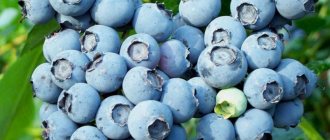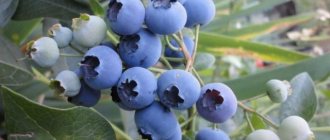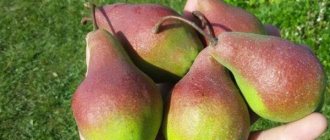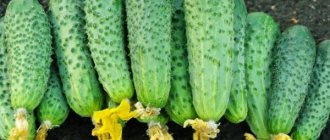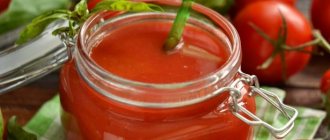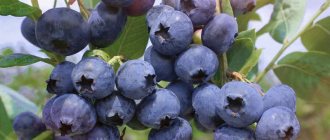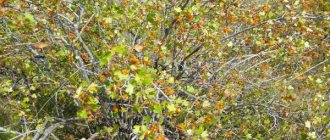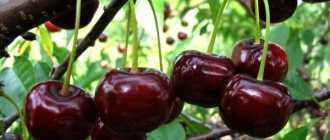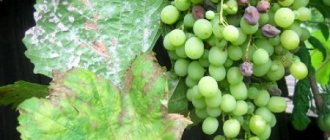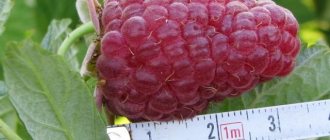Description of the Northland blueberry variety
An early ripening plant that can be grown in northern regions due to its increased frost resistance.
Northland blueberry is a low, spreading bush with a round shape and powerful shoots. It grows up to 1 - 1.2 m, produces a lot of even, straight growth, and is therefore characterized by density. Young shoots are light green all year round. The root system is superficial, fibrous, without root hairs. Northland leaves are medium-sized, oblong in shape. In spring and summer they are green, and in autumn they are fiery red. The leaf length reaches 2.7 - 3 cm.
Northland blueberries in the photo:
The branches of Northland blueberries are quite flexible, so they do not break under large amounts of snow. Small inflorescences are in the form of bells, pale pink in color, and have five cloves. The flowers can withstand light frosts, which does not harm pollination.
Description of berries
Northland blueberries bear round fruits with a rough skin: the berries are medium-sized, can reach 1.6 cm in diameter, light blue in color with a bluish tint, and have a small dry scar.
The maximum weight of the Northland variety reaches 2 g. Blueberry pulp is sweet, pleasant, with a fragrant aroma. The tasting rating for the Northland berry was 4.0 on a five-point scale, which proves its high taste.
Product description
The “Northland” variety is early ripening. You will be able to enjoy the berries already in mid-July. The bush is low, about 1-1.2 m in height, but quite powerful and spreading. Blueberries are medium sized and blue in color. The taste of the berries exceeds all expectations. The skin is not rough. Ripe blueberries store very well and do not spoil for a long time. The “Northland” variety bears fruit consistently (about 4-5 kg every year), but with proper care of the plant you can harvest a record 8 kg.
Northland blueberries - most resistant to winter frosts
A detailed description of the variety allows you to understand whether blueberries are able to adapt to your garden conditions and what care they need.
Blueberries look beautiful all season long. In spring it attracts the eye with its pale pink buds and young green leaves, in summer with blue berries and flowers, and in autumn with fiery red leaves. Therefore, gardeners sometimes use this variety in rock gardens as an ornamental shrub. Blueberries can be safely planted together with coniferous trees or created as a hedge along the fence.
Diseases and pests of blueberries
Blueberries can be susceptible to a number of diseases.
Stem cancer is a fungal disease. Brown spots appear on the branches, the diameter of which increases over time, the bark dries out, and the leaves become red-brown.
Botryosphere flower rot - affects the entire plant. The shoots dry out and the leaves fall off.
Drying branches or Phomopsis is a fungal disease, the symptoms are similar to stem cancer.
Mummification of berries is also a fungal disease, manifested by the withering of inflorescences and branches, the fruits dry out and fall off.
Gray rot or botrytis - flowers and branches turn brown, berries are covered with gray fluff.
Moniliosis or fruit rot - the tops of the shoots turn yellow, in general the bush looks as if it has been damaged by frost.
Anthracnose or fruit rot is a fungal disease that appears as spots on leaves and fruits (orange dots).
Red leaf spot is a viral disease; small red spots appear on the leaves, and shoot growth is slowed down.
Also viral diseases of blueberries are: red ring spot, mosaic, filamentous branches.
The affected areas will need to be removed and treated with an appropriate fungicide. Prevention of diseases is the correct planting of high-quality seedlings, follow the rules of care, also collect fallen leaves and berries from the site, and do not overdo it with nitrogen-containing fertilizers. Apply Bordeaux mixture twice a season (before flowering and after fruiting ends).
Blueberry pests: aphids, caterpillars, leaf rollers, flower beetles, bud mites, beetles. Use insecticides to control pests. To protect the crop from birds during the fruiting period, the plantings should be covered with a net.
History of selection
The name of the blueberry variety Northland (“Northland”) translated from English means “Northern Land”. It was obtained at Michigan State University (USA) as part of a program to develop the most frost-resistant varieties of this crop for cultivation on an industrial scale.
Work on it was carried out by S. Johnston and J. Moulton since 1948. Scientists managed to cross the high-bush Berkeley blueberry with 19-N (a hybrid of the low-bush blueberry and a seedling of the Pioneer variety).
Northland became the result of their work in 1952. This blueberry variety was officially introduced into cultivation in 1967.
Rules for growing the variety
Caring for this variety of blueberry is quite traditional; it needs to be provided with watering, loosening the soil, removing weeds and fertilizing. Varietal blueberries are usually not picky, but compliance with growing standards is necessary so that the shrub can show good yield.
There are no special requirements for loosening the soil. It is enough to carry it out on a regular basis, not going deeper than 10 cm, otherwise there is a risk of damaging the roots
Particular attention should be paid only to watering and maintaining optimal soil acidity at 3.5-4 Ph. Due to insufficient watering, blueberries become very small and sour. Normal watering for blueberries is 10 liters of water per bush once a week, dividing this volume into morning and evening
When the berries are forming, you need to water the bush twice as often, thanks to this the fruits will gain maximum shape and juiciness. You should not increase the volume and frequency of watering, as this leads to rotting of the roots. In dry summers, the plant will respond well to foliage irrigation in the evening; Nordland is not picky about fertility and shows good yield even on depleted soils. However, to obtain the maximum possible yield, fertilizing is necessary.
Normal watering for blueberries is 10 liters of water per bush once a week, dividing this volume into morning and evening. When the berries are forming, you need to water the bush twice as often, thanks to this the fruits will gain maximum shape and juiciness. You should not increase the volume and frequency of watering, as this leads to rotting of the roots. In dry summers, the plant will respond well to foliage irrigation in the evening; Nordland is not picky about fertility and shows good yield even on depleted soils. However, to obtain the maximum possible yield, fertilizing is necessary.
Blueberry Northland
It is important to know! Organic fertilizers are not applied to blueberries because of their ability to reduce soil acidity, and this plant is demanding in maintaining acidity at a certain level. Mineral fertilizing should be done before the active vegetative phase begins (until the buds swell) and repeated after 1.5 months. Ammonium, potassium and zinc sulfates can be used as fertilizer; complex fertilizer for heathers is well suited
Ammonium, potassium and zinc sulfates can be used as fertilizer; complex fertilizer for heathers is well suited.
You can determine the need for a particular fertilizer by the appearance of the plant:
- Yellow foliage and stunted growth - lack of nitrogen;
- Redness of the leaves - lack of phosphorus;
- Dying of young branches - lack of potassium.
All fertilizers are applied according to the dosages indicated on the packages.
- Forming a bush is an important stage, which includes pruning and tying up branches. The crown of the Nordland blueberry often grows strongly and becomes very spreading. To give it a more compact shape, gardeners resort to gartering branches, although this procedure is not mandatory. But pruning for blueberries is very important. In the spring, for sanitary purposes, it is necessary to remove dead and diseased branches, as well as those that have broken off and bent to the ground under the weight of snow. The blueberry crown develops very slowly and does not require formative pruning. In order to increase productivity, you can remove shoots that are more than 7 years old, and in order to get larger berries, you can trim five-year-old branches, but you should not get carried away - the tree grows shoots very slowly.
Pruning blueberries in spring
Subsequent care of the crop
The Northland blueberry variety is unpretentious in terms of care. However, there are certain nuances that should be taken into account so that the plant does not get sick and produces stable yields.
Necessary activities
It is recommended to water Northland blueberries regularly (about once a week, more often during the fruiting period - once every 4-5 days). Approximate norm: 1 bucket of water per adult plant. It should be divided into 2 doses - morning and evening.
Advice! To water the bushes of this variety, it is also convenient to use special drip irrigation systems.
Northland blueberries should be fertilized with mineral (nitrogen-containing) or complex fertilizers in three stages:
- at the beginning of sap flow (half of the annual norm);
- another quarter is introduced at the time of flowering;
- the remainder is added during the harvest.
Warning! You cannot feed blueberries with organic fertilizers - they are destructive for them!
Necessary procedures for caring for Northland blueberries include loosening the soil. It is carried out several times during the season. It should be taken into account that the roots of the plant are located close to the surface - accordingly, the soil should be loosened carefully, without going deeper into the ground than 10 cm.
An important technique that helps suppress the growth of weeds, retain moisture and enrich the soil with organic matter is mulching. The layer of mulch under the bushes of this blueberry variety can be within 5 cm. As such, you can use cut grass, peat or crushed tree bark.
Shrub pruning
Regular and proper pruning of Northland blueberries is the key to its health and productivity.
For sanitary purposes, this procedure is carried out in the spring, starting from 2–4 years of age of the bushes. It helps to form a strong skeleton of the plant and serves as a prevention of branch fractures during the fruiting period under the weight of the berries.
Important! To increase the yield of Northland blueberries, it is recommended to prune shoots older than 6–7 years.
In summer and autumn, dried and diseased branches are removed by pruning.
It is recommended to remove flowers from annual plants of this variety in the spring.
Preparing for winter
Northland is a frost-resistant blueberry variety. However, in regions where low temperatures can last for a long time, it will need shelter in winter.
As such, burlap, spunbond or any other breathable material is used, stretched over a base of pegs or arcs.
Important! Polyethylene film cannot be used for these purposes!
How are garden blueberries different? Photos are attached!
Before you start studying this berry crop in detail, you need to know the history of its origin. How do garden blueberries differ from their natural “wild” counterparts?
This page contains photos of garden varieties, which are primarily distinguished by higher growth of shoots and a large number of berries on 1 stem.
In addition, it is worth paying attention to the size of the berries and the yield from 1 bush. The prototype of this culture is the wild swamp berry, which grows in nature on peat bogs and in marshy areas. The prototype of this culture is the wild marsh berry, which grows in nature on peat bogs and in marshy areas.
The prototype of this culture is the wild swamp berry, which grows in nature on peat bogs and in marshy areas.
Its prevalence in a large number of regions is explained by its excellent resistance to unfavorable growing conditions. These plants thrive even in tundra conditions, complementing the sparse landscape of this area.
In the wild, one bush can grow well and bear fruit for more than 50 years.
In culture, such indicators are difficult to achieve, since rejuvenation of the branching part does not occur. Therefore, garden blueberries are usually replanted with new cuttings at least once every 6 years. Otherwise, the yield drops catastrophically due to a decrease in the size of the berries.
Popular wisdom subtly noted all the beneficial and amazing properties of this berry. So, for its love for the neighborhood with wild rosemary, the culture is called a drunkard. This is due to the fact that during the ripening period of the berries it is usually hot; this condition contributes to the release of a large amount of specific essential oils by wild rosemary.
When they are inhaled, a person becomes slightly intoxicated. It goes without saying that the next day you will have a headache, like a hangover. Therefore, it is natural to have another name - hemlock.
But the popular name blueberry is explained even more simply. The berry secretes a characteristic blue juice that stains hands, fabrics and everything it comes into contact with blue.
How else do garden blueberries differ from their wild counterparts besides their higher growth (70 cm versus 25-30 cm in the wild)? Well, at least the period of entry into fruiting.
In nature, this berry takes a long time to develop; it requires at least 15 years of growth and development in order to produce the first berries. But with garden varieties everything is much simpler.
Most of them begin to produce moderate yields already in the second year after planting. The bushes reach full strength 3 years after planting.
Look at the photo of garden blueberries - the elegance and grace of the bushes strewn with clusters of magnificent aromatic berries:
Collection and storage of blueberries
Northland usually begins to bear fruit at 2 years of age and, in favorable conditions, produces crops for up to 30 years. Its berries are collected both manually and mechanically on industrial plantations. It is worth noting that the berries fall off quite quickly, so harvesting should be done 2-3 times a week. It is important to remove the fruits very carefully and try not to shake them.
Find out more about when blueberries bear fruit.
It is better to collect berries immediately into storage containers . If the fruits are planned to be transported and stored for a long time, they should be collected a couple of days before full ripeness. The berries should be fairly firm and have a uniform color. They can be stored in the refrigerator, bearing in mind that after 2-3 weeks their quality may decrease significantly. Optimal parameters for long-term storage are a temperature of about 0°C and a relative humidity of 90–95%.
You can also store blueberries:
- frozen;
- in dried form;
- grated with sugar.
At the same time, it is better to keep dried berries in a dry room in linen bags, and jars of candied blueberries in a cool cellar, basement, or refrigerator.
Diseases and pests
The characteristics of the culture indicate that the variety is immune to some diseases. According to reviews from gardeners, Toro, like the Eliot variety, can be subject to chlorosis, mummification of fruits, septoria, and gray rot. Signs of disease are yellowing or any other change in the color of the leaves, damage to the roots, the entire bush or berries begin to dry out. A signal that the plant is unhealthy is the abundant dropping of fruits.
Damage to blueberry leaves
Various chemicals that are sold in stores are suitable for treatment. You can’t delay this. Damaged leaves and shoots are removed. Experienced gardeners prefer to practice disease prevention.
Prevention methods include the following:
- You should buy only healthy, strong seedlings;
- During planting, the soil is fertilized and its acidity is monitored;
- During the summer, shrubs are sprayed with fungicides, for example, Bordeaux mixture.
Among the pests that attack the plant: caterpillars, aphids, flower beetles. Exactly the same insects haunt the Elliott blueberry. Pests need to be controlled with insecticides.
Do blueberries need to be pruned?
Pruning is a very important procedure in caring for any crop, including blueberries. Thanks to this technique, the quality and quantity of the harvest can be improved. Experienced gardeners know that improper pruning of a bush can lead to the fact that the work and time spent on other agrotechnical methods of care and cultivation will be in vain. Pruning is carried out with a clear and predetermined purpose.
Young bushes 2-4 years old are pruned to form a strong skeleton so that the branches can withstand the harvest. Therefore, all fruit buds are removed from the plant. With each subsequent year, small growths should be trimmed, as well as diseased branches and branches lying on the ground.
Pruning adult bushes can be carried out for 2 purposes. Namely :
- The fewer branches are pruned, the greater the harvest, but the smaller the berries and the later their ripening.
- And vice versa, the more the bush is pruned, the larger and earlier the berries will be.
The intensity of pruning bushes with fruit depends on what goal the gardener is pursuing. To obtain a larger berry, it is necessary to cut out all parts of the bush that are more than 5 years old. If the size of the berries does not matter, it is worth pruning only branches that are more than 7 years old. But it is still important to remove parts of the bush with flowers, including those that are diseased or have fallen to the ground.
Northland blueberries have a spreading type of bush, so there is no need to thin the bush in the middle. Particular attention should be paid to the lower drooping branches. If they touch the ground, various pests or insects can climb on them. The “Northland” variety is not prone to strong shoot formation, so there is no need to remove some of the fruit buds.
Recommendations for planting crops
Blueberries should be planted in the right place, calculating the timing. The plant must take root and the seedlings must develop a root system before the onset of frost. The soil should be chosen fertile, where similar crops have not grown before. The berry does not require any special planting technologies.
Landing dates
It is advisable to plant blueberries in the spring, before buds begin to bloom. It is not advisable to carry out planting work in autumn, since the weather is unpredictable
It is important that there are 2 months left before the first cold weather. Only then will the shrub adapt to new living conditions and not die in winter
Selection of berry seedlings
Experienced gardeners advise buying 1-year or 2-year-old planting material. It better tolerates the stress that planting in open ground causes. Bushes should be looked for from trusted sellers or specialized stores. It is not advisable to buy from the market; you may end up with a wild seedling or the wrong variety. Before paying, inspect the seedling for integrity; it must be healthy and vaccinated. The roots are strong, without scratches or chips.
Preparing the soil and planting hole
Blueberries grow well in acidic soil pH 5.0-5.5. If the soil does not meet the above criteria, add fresh manure, pine needles, peat, colloidal sulfur, or water the intended area with acetic or citric acid. The substrate should be light and breathable. On heavy soils, blueberries will grow poorly or die out.
The rhizome is superficial, the average depth of the hole should be 40 cm, diameter – 0.5 meters. When planting, simultaneously maintain a distance between seedlings equal to the volume of an adult bush. A drainage layer 5 cm thick is made at the bottom. It consists of brick chips, expanded clay, pebbles, and clay shards. A mixture of peat, river sand, and pine sawdust is placed in the recess. The components are taken in equal proportions.
Nitroammofoska, Azofoska, Diammofoska, 40 grams each, are added from the top-up. Mycorrhiza is added to the planting hole. This is a kind of “fringe” on the tips of the rhizomes of plants of the Heather family. Mycorrhiza helps the bush develop properly. If the planting material was purchased from a nursery, there is no need to add anything; the “fringe” is already present in the top layer of soil.
It should be preserved, like the water where the seedling was soaked. Only the planted bush is watered with it. Mycorrhiza is purchased as a dry concentrate in garden stores. You can get it yourself by going to the forest where blueberries, lingonberries, and cranberries grow. Cut a small amount of turf with rhizomes, chop, add to the hole.
Bush planting technology
Proper selection of a site for planting blueberries is the key to a bountiful harvest in the future. It is advisable to give preference to areas well lit by the sun. Lack of heat has a detrimental effect on the taste of the fruit, they acquire a sour taste, and the skin becomes rougher. Groundwater must lie closer than 50 cm to the surface, or you will have to make a hill 20 cm high.
Landing technology
Growing Northland blueberries in regions with a variable climate is not easy, but it is quite possible, the main thing is to initially create favorable conditions for it to grow.
Deadlines
It is recommended to carry out planting work either in early spring, when it is warm and the threat of return frosts has passed, or in the fall. But it is preferable to plant Northland blueberry seedlings in the spring so that they have time to adapt to new conditions and prepare for wintering.
Preparing the soil and planting hole
For better growth and development, you need to choose a site for planting Northland blueberries in a clearing that is well-lit and protected from cold winds. Planting in the shade does not bring the desired results. It is not advisable to place the bushes near tall garden plants, otherwise the berries will be sour.
The soil at the planting site should not be depleted; the seedlings are in great need of nutrients. The best option is light, well-drained soil, saturated with useful components - humus. The acidity index should be in the range of 3.5-5.0. To grow crops, it is effective to use high-moor peat or a composition based on it.
Preparing a seedling
To avoid problems with the plant in the future, it is recommended to purchase planting material from special nurseries or at exhibitions. The seedlings must be with a closed root system, two years old and shoots 35-50 centimeters long. Before planting, the container with the plant should be kept in a container of water for 30 minutes.
Algorithm and landing scheme
In order for a young plant to take root and grow faster, you must adhere to the following technology:
- Dig a hole 50 centimeters deep and 50-60 centimeters wide.
- Place a drainage cushion made of expanded clay, pebbles, and crushed stone on the bottom (layer thickness 7-10 centimeters).
- Fill the hole with a nutrient composition of peat, soil, coniferous litter and humus to 10-15 centimeters.
- Place the prepared seedling in the center of the hole and straighten its roots.
- Sprinkle with soil mixture and compact it carefully so that there are no voids.
- Mulch with sawdust, peat or pine nut shells (layer thickness 5-10 centimeters).
- Moisten the soil with acidified water, where 40 grams of citric acid are used per 10 liters of liquid.
See also
Description of the Chandler highbush blueberry variety, planting and care rulesRead
The optimal distance between plantings is 1.5 meters, and between rows 2-2.5 meters.
Description of the berry crop
The description of the blueberry variety Bluecrop should begin with the fact that the plant is planted not only for the purpose of harvesting, but also as an ornamental shrub. Changing the color of foliage in accordance with different seasons looks very impressive in gardens and personal plots.
General idea of the variety
The height of the Bluecrop blueberry is about 1.6-1.9 m, and the width of the crown is about 1.7-2 m. The leaves have a jagged edge, an oblong, slightly elongated shape and a characteristic bright green color.
The shoots are erect, spreading and strong. The Bluecrop blueberry root system is fibrous, devoid of villi and located at a distance of 35-40 cm from the surface of the earth.
The flowers are white with a greenish tint, no more than 1-1.5 cm in length. In their shape they resemble barrels or bells.
Bluecrop blueberries grow only in cold regions, so planting the crop in the south is pointless. The plant requires acidic peaty soils, which are available only in the northern regions.
Berries
The fruits are deep blue, quite large, about 2 cm in diameter, and have a pronounced bloom. The weight of each berry varies between 1.8-2.5 g. Bluecrop blueberries taste sweet and sour.
The fruits grow in dense clusters, which ripen within 20-25 days after flowering. For clarity, below is a photo of Bluecrop blueberries.
Characteristic
Characteristics of Bluecrop blueberries have their own characteristics that distinguish them from other varieties. For example, the shrub is highly frost-resistant, which allows plants to be grown in regions with cold climates. This variety is most often cultivated in the United States as an industrial crop.
Main advantages
Frost resistance of Bluecrop blueberries is one of the main advantages of the variety. The shrub can tolerate temperatures down to -30-32° C. The advantages of Bluecrop over other varieties include:
- relative resistance to drought;
- immunity to most diseases;
- regular and abundant fruiting;
- good keeping quality and transportability of berries.
In addition, the plant is unpretentious in care and does not require special preparation before the onset of cold weather.
It is only important to follow the watering regime, regularly weed and mulch the planting site, and also trim the shoots
There are a lot of blueberry varieties, they are often compared with each other. For example, Bluecrop and Northland blueberries have several differences. Bluecrop ripens later, but you can collect 2-3 kg more berries from one bush than from Northland blueberries. In addition, Bluecrop is resistant to a wider range of diseases.
Flowering period and ripening time
Bluecrop blueberries are most often cross-pollinated. Therefore, to obtain a harvest, it is necessary to plant other varieties with the same flowering periods next to the shrub.
The plant begins to bloom in May, and at the end of July the first berries appear. In this case, the ripening of blueberry fruits occurs unevenly.
Yield indicators, fruiting dates
Tall blueberries Bluecrop demonstrate high yields. From one adult bush you can collect about 8-10 kg of berries. The crop begins to bear fruit from late July to early August. Harvest dates may vary depending on the climate and characteristics of the region.
Area of application of berries
The blueberry variety Bluecrop is widely used for making jams, preserves and other winter preparations from tasty and ripe berries. The fruits can also be eaten fresh.
Resistance to diseases and pests
The description of Bluecrop garden blueberries also includes resistance to various diseases and pests. This crop has average resistance to most viruses and pathogens.
Advice! Proper care and disease prevention will increase the plant's immunity several times.
Advantages and disadvantages of the variety
Numerous reviews of Bluecrop blueberries indicate the following advantages of this variety:
- high yield rates;
- cold resistance;
- good taste of fruits;
- immunity to a wide range of diseases;
- easy care;
- large berries;
- good transportability.
The disadvantages include:
- long ripening of berries;
- excessive branching of shoots;
- overload of bushes with berries.
But, despite these shortcomings, Bluecrop is the standard for other blueberry varieties.
Characteristics of the variety
According to the description of the Northland blueberry, the plant is designed to grow in areas with harsh climates. The yield of the variety is consistently high, agricultural technology is minimal, but it is necessary to water and treat with protective agents.
Main advantages
Blueberry Northland:
- Tolerates temperature drops down to -35 °C.
- It has a strong skin, which allows the crop to be stored for a long time and transported over long distances without losing its presentation.
- Unpretentious in care - does not require complex agricultural technology.
Flowering period, ripening time, yield
The bushes begin to bear fruit in the second year after planting. The average lifespan of a plant is 30 years. It needs other blueberry varieties to cross pollinate. Great for Patriot, Bluecrop, Rubel. The yield of the Northland variety is high - 3 - 4 kg of berries can be collected from a bush. Proper care, watering, and fertilizing will increase the number of berries to 8 kg per square meter. m.
The Northland variety blooms profusely, beautifully, for a long time - 20 - 25 days at the end of spring. Ripening is unfriendly, begins in the second ten days of July, and ends at the end of August. Ripe garden blueberries fall to the ground, so it is recommended to harvest them at least 2-3 times a week.
Area of application of berries
The fruits are stored for a long time in frozen, dry form. They can be eaten fresh, made into jam, compotes, or used for filling pies. Baking turns out delicious if you add raspberries and cherries to blueberries.
Resistance to diseases and pests
Northland highbush blueberries resist most viral and fungal diseases, but not all. The variety can affect:
- gray rot;
- stem cancer;
- physalosporosis;
- moniliosis.
Pests love blueberries:
- aphid;
- flower beetle;
- kidney mite.
Attention! The berries are often eaten by birds. To scare them away, it is recommended to tie multi-colored fabric ribbons or strips of polymer film to the branches of the Northland shrub.
Advantages and disadvantages of the variety
Blueberries have many benefits:
- increased frost resistance;
- abundant yield;
- excellent taste;
- decorative appearance;
- good preservation of fruits;
- transportability;
- early maturation;
- low maintenance requirements;
- resistance to pests and diseases.
The disadvantages of culture are:
- low drought resistance;
- sensitivity to drafts;
- demanding soil acidity;
- slow development, reproduction;
- when affected by the disease, it is often necessary to burn the entire bush.
Description of the variety
Northland blueberries are tall varieties, reaching an average height of 1 m 20 cm. The harvest ripens early - in the second ten days of June. The fruits are large (about 2 g), have a sweet taste and pronounced aroma, and have a delicate skin. The yield is on average 5 kg per bush, in good growing conditions - up to 8 kg per bush. The berries are highly preserved and are often used in cooking for canning and making jams.
This is a collective plant, so it is recommended to grow it in plantations rather than individually, since during flowering this variety needs a pollinator. The bushes have a developed crown and a powerful trunk. The decorative appearance allows the use of shrubs to decorate the garden. Landscape designers often use them to create alpine slides and hedges, combining them with coniferous shrubs and trees. Plants easily tolerate frost, but are not resistant to drought.
Nordland blueberries, which love well-lit areas, in the shade the yield drops several times. Drafts and strong winds also negatively affect the characteristics of the plant. The description of the Northland blueberry variety almost completely coincides with the description of such a berry as the Chanticleer blueberry, which is known for its versatility and unpretentiousness. Both of these varieties are ideal for planting in the northern regions of Russia. They tolerate harsh winters well, and in the summer they produce a bountiful harvest that is distinguished by excellent taste.
Planting work can be done both in summer and autumn, but early spring is considered the optimal time, since the bushes have time to gain strength during the summer period, and winter will not be a test for them. For planting, it is best to choose a two-year-old plant, up to half a meter high, with closed roots. Externally, the bush should look neat, the leaves are intact and not drooping. A healthy blueberry seedling is the key to successful blueberry growing.
Planting holes should be placed at a distance of 1.5 m from each other, their depth should be 0.65 m. At the bottom of the hole, a drainage layer of sand and gravel mixture should be laid and soil should be filled. The seedling must be carefully removed from the pot so as not to damage the roots, then it must be placed in the center of the hole, and the roots should be evenly distributed around the trunk. Now the roots can be covered with soil so that the root collar is flush with the ground, but a small depth is allowed, up to 2 cm. The top of the planting area must be mulched with peat.
Reviews about the variety
Northland blueberries have proven themselves predominantly on the positive side. It is chosen for its relative unpretentiousness to living conditions and high productivity.
Alexey, 56 years old, Saratov
I planted the variety quite recently, but have already managed to evaluate its frost resistance. Of course, I still covered the young plants, and when they grew up, they cope with low temperatures quite well.
Anna, 46 years old, Novgorod
I liked the Northland blueberry for its high yield and low maintenance requirements. There is no special need to carry out formative pruning; it is enough to water the plant in a timely manner and add nutrients.
Garden highbush blueberry
From one bush you can get up to 10 kilograms of berries. The homeland of this perennial deciduous shrub is North America.
It grows wild in the eastern United States and Canada. Today, breeders have created many varieties adapted for cultivation in Europe, as well as in Australia and New Zealand. In the European part, blueberries can grow not only in the northern regions, but also in areas with a warmer climate. You will not regret if you plant this plant on your site.
In the spring, the bushes delight with beautiful flowering, in the summer with berries, and in the fall the leaves acquire a crimson hue. Blueberries can be successfully used in landscape design. It tolerates cutting well and can even be used as a hedge.
Highbush blueberry Breeders call the following varieties the best varieties of the species:
- Berkeley - reaches a height of 2.1 m when mature and has light green leaves. The fruits are large – up to 19 mm, ripen in mid-August;
- Spartan is an upright variety, with a height of up to 2 m. It has been actively planted around the world since 1977. The berries ripen relatively quickly, from July. From one bush it is possible to obtain from 4.5 to 6 kg of fruit;
- Bluecrop is one of the most famous and best-yielding varieties. It began to be used by farmers and gardeners in 1944. In one season it can provide up to 9 kg of berries;
- Elliot is an erect bush that can grow to a height of 2 m. The fruits of the plant are light blue and juicy. Although the berries are medium in size, they can be kept fresh even for 12 weeks.
Blueberry Elliot
Blueberry diseases
Northland can be affected by various diseases - gray mold, physalosporosis, moniliosis. To combat them, the drugs Topsin, Fundazol, and Bordeaux mixture are used. To prevent these diseases, it is very important to prevent stagnation of moisture in the soil and an excess of nitrogen-containing fertilizers.
Northland highbush blueberries are a popular variety valued by gardeners for their high yields. It is frost-resistant, easy to care for and has excellent berry taste. If the mandatory agrotechnical rules are followed, Northland will become a real decoration of any garden and will bring a generous harvest of tasty and juicy berries.
Tips and tricks for growing
Blueberry seedlings are sold at two years of age, with a shoot length of 35–50 cm and a closed root system. This form of pre-sale preparation allows for optimal survival.
The plant prefers well-lit, draft-free places. In the shade of fruit trees, the berry will not be able to gain enough sugar, so their proximity is undesirable.
The acidity of the soil should be at the level of 3.5–4 pH, it can be increased by adding acids: acetic, citric or oxalic.
Early spring is considered the ideal time, so the young bush will have time to get as strong as possible before the winter cold. Although planting is possible in summer and at the very beginning of autumn.
Holes for planting are dug at a distance of 150–160 cm. The seedlings are buried flush with the earthen ball, straightening the roots. To gently straighten the roots, you can briefly place them in water before planting.
- dig a deeper and wider hole, 60–65 cm in depth and width, the bottom is drained with a layer of gravel and sand;
- the planting hole is filled with a mixture of peat, sand, pine needles and sawdust;
- An earthen ball of seedlings is placed in this mixture and covered with mulch on top.
After planting, the bush is watered with water with the addition of citric acid - 40 g per 10 liters. When the Northland blueberry has successfully completed the planting procedure, it’s time to provide it with good care, which consists of loosening, watering, fertilizing and pruning.
Loosening the soil is carried out regularly, but not deeper than 10 cm, since the roots can be damaged.
Water at least twice a month. During the period of flowering and ripening of berries, watering is increased. During heat and drought, it is recommended to irrigate the leaves of the bush with warm water in the evening.
Although the berry grows well in poor soils, fertilizing is necessary to increase productivity. Mineral fertilizers are applied twice in the spring: the first time before the buds swell, the second time after 1.5 months. The composition of fertilizers is selected based on the appearance of the foliage:
- when it turns yellow and growth slows, nitrogen is added;
- redness of the leaves indicates a lack of phosphorus;
- death of young shoots - potassium.
To increase yield, shoots older than seven years are pruned. Pruning five-year-old branches allows you to enlarge the berries.
Protection from diseases and pests
Microorganisms—symbionts—live on the roots and in the soil around the bush, giving the plant additional protection. For them to work effectively, the soil must be regularly loosened and weeds removed.
Fungal diseases affect various parts of the bush: branches, berries, leaves. In this case, all damaged branches are cut off and burned. Plants are treated with fungicides. The most effective are Euparen and Topsin. In spring and autumn, Bordeaux mixture is sprayed for prevention.
Among the harmful insects for blueberries, pine silkworms, earwigs, scale insects, and aphids are dangerous. Pests are removed manually, with the help of a ladybug (this is a natural enemy of silkworms and aphids) or with the help of insecticides.
To prevent birds from eating the berries, strips of shiny and rustling polymer film are tied to the bushes.
Features of growing blueberries
Growing blueberries requires following some rules:
- Garden blueberries are a rather difficult crop to propagate. Only wild species reproduce by seeds. Gardeners use vegetative propagation methods: cuttings or layering.
- For planting, you should choose 2–3-year-old seedlings with a closed root system. It is better to buy planting material in special nurseries. A dug up wild blueberry seedling (for example, in a forest), as a rule, does not take root in the garden due to the crumbling of a clod of earth when the plant is removed from the ground. This is explained by the fact that along with the soil, saprophytic fungi that live on the roots and participate in the nutrition of the plant also fall off. After this, the seedling does not survive in the new conditions.
- Blueberries grow only in acidic soils (pH - from 3.5 to 5.0). In a neutral or alkaline environment, the plant begins to hurt, growth slows down and may die. Therefore, it is often necessary to prepare a separate area for blueberries with a soil composition that differs from the main one. To acidify the soil, use ground sulfur (250 g per 1 m3 of land) or apply mineral fertilizers (ammonium sulfate, urea, ammonium nitrate, potassium sulfate, nitroammophosphate).
- An open area protected from the wind is suitable for sun-loving blueberries.
- Blueberries are a moisture-loving plant that needs constant moisture, but without stagnant moisture. Areas with close groundwater (50–60 cm) are ideal for planting crops.
- Experienced gardeners recommend sowing healthy green manures - lupine and oats - before planting blueberries.
- Blueberries are planted both in spring and autumn. Gardeners consider spring to be the best time, when by winter the plant has time to take root well, adapt and is less exposed to freezing. On the other hand, bushes that take root after autumn planting grow as hardened and viable as possible.
Chemical composition
100 g of raw blueberries contains:
- proteins - 1.0 g;
- fats - 0.5 g;
- carbohydrates - 6.6 g;
- dietary fiber - 2.5 g;
- organic acids - 1.4 g;
- ash substances - 0.3 g;
- sugar - 6.6 g;
- water - 87.7 g;
- calories - 39 kcal.
One 250 ml glass contains about 260 g of blueberries, or 101.4 kcal, and a 200 ml glass contains 160 g of berries, or 62.4 kcal.
| Vitamin composition | Mineral composition |
| thiamine (vitamin B1) 0.01 mg | potassium 51 mg |
| riboflavin (vitamin B2) 0.02 mg | calcium 16 mg |
| Niacin (vitamin B3) 0.3 mg | magnesium 7 mg |
| ascorbic acid (vitamin C) 20 mg | sodium 6 mg |
| alpha-tocopherol, TE (vitamin E) 1.4 mg | phosphorus 8 mg |
| vitamin PP, NE 0.4 m | iron 0.8 mg |
Rules of agricultural technology and care
Basically, caring for Northland blueberries comes down to irrigation, loosening the soil, and adding nutrient mixtures.
Watering and fertilizing
Blueberry bushes should be moistened regularly, once every 7 days. And in the fruiting phase - once every 4-5 days. The volume of water per adult plant is 10 liters. Divide it into 2 doses, irrigating the bushes in the morning and evening hours. It is more efficient to use a drip irrigation system for watering blueberries.
For feeding procedures, it is recommended to use preparations with a high concentration of nitrogen, as well as complex mixtures. Fertilizer is applied for the first time at the initial stage of sap flow, the second time during the flowering phase, and the third time during the formation of ovaries.
It is undesirable to add organic compounds to the soil; they have a detrimental effect on blueberry bushes.
Mulching and loosening beds
To prevent cultivated plants from experiencing a deficiency of nutrients and moisture, it is necessary to periodically remove weeds near them. Loosening the soil will allow you to avoid oxygen starvation of the roots, but it should be done carefully, to a depth of 10 centimeters.
To retain moisture in the soil, you need to use mulch, for example, peat, sawdust, crushed tree bark, grass. The layer thickness should be from 5 centimeters.
Formative pruning of shrubs
Considering the slow growth rate of shoots, you should not get too carried away with pruning them. To create a more compact shape, the branches of the bush should be tied up. In the spring, the plantings are inspected and removed from incompetent branches, including those infected with pathogenic microorganisms.
Pruning helps prevent them from being damaged by the weight of snow. To increase the productivity of Northland blueberries, shoots that are older than 7 years are removed, and to increase the size of the berries, five-year-old branches are pruned.
Methods of control and prevention against diseases and insects
To combat stem cancer and gray rot, it is recommended to avoid waterlogging of the soil and excessive amounts of nitrogen-containing fertilizers. In case of infection with these ailments, Fundazol and Topsin work effectively. Similar drugs are used for physalosporosis, and Bordeaux mixture has proven itself well against moniliosis.
Insecticidal agents such as Actellica, Karate, Calypso will help protect plantings from aphids. It is possible to fight the kidney mite with the help of iron sulfate, Nitrofen, KZM. You can defeat the flower beetle by using Fufanon and Intavir.
Preparing for winter
When growing Northland blueberries in areas with harsh winters, additional coverings should be used: spunbond, burlap. The use of polyethylene can lead to rotting of the bushes. In addition, you should add fertilizer with a high concentration of magnesium to the soil (at the end of August).
Diseases and pests, methods of control and prevention
The most popular diseases that will most likely affect Northland blueberries are:
Control and prevention measures
The appearance of reddish spots on the leaves and bark, they very quickly become dark and become larger in size. The stems begin to dry out
Affected organs must be cut out and burned. Treatment with fungicides (Topsin, Fundazol). To prevent this, beware of waterlogging of the soil and excess nitrogen fertilizers.
Infected organs (branches, leaves, fruits) first acquire a brown or reddish color, then turn gray and quickly die
Small swollen reddish spots appearing on young branches. The next year, extensive wounds appear on the shoots, helping them die off.
Pruning and burning affected branches. Spraying with Bordeaux mixture, Fundazol, Topsin
Fungal infection of flowers, leaves, and branches that begin to look as if damaged by frost. Fetuses suffering from moniliosis are mummified
Treatment of plants with Bordeaux mixture after harvesting
There are not very many pests that interfere with this blueberry variety. The most popular of them:
Appearance and activity
Control and prevention measures
Colonies of very small insects on shoots and young leaves at the bottom of plants. Carrier of a number of viral diseases (stem cancer). Affected organs change
Effective treatment with insecticidal preparations (Karate, Calypso, Actellik)
Tiny (0.2 cm) white insect with 4 long legs. Overwinters in leaf axils. Starting in the spring, it settles on leaves, buds, and flowers. It feeds on plant sap. Galls appear on the bark, becoming the focus of viruses
Treatment before bud break with metallic sulfate, Nitrofen, KZM preparations
A small (0.4 cm) dark beetle whose body is covered with brown specks. A large specimen injures the kidneys. The larvae feed on the stamens and pistils of flowers and secrete mucus, which prevents the buds from opening. Flowers dry and fall
Treatment of soil and blueberry leaves with Fufan and Intravir. Periodically shaking off and collecting insects from branches
